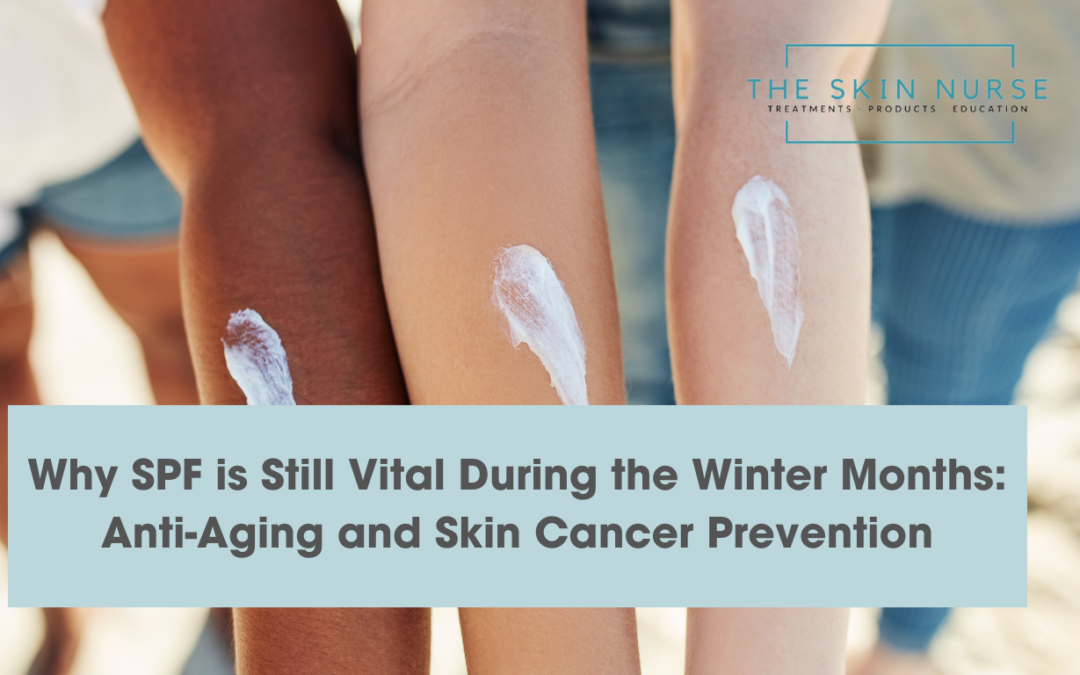As the days grow shorter and the temperature drops, it’s easy to assume that SPF can take a backseat in your skincare routine. After all, if the sun isn’t shining as brightly, do we really need to worry about sun protection? The answer is a resounding yes! Even in the colder, darker winter months, SPF remains a crucial part of maintaining healthy skin, preventing premature aging, and protecting against skin cancer.
As a Dermatology Nurse and aesthetic specialist, I cannot emphasize enough how important it is to keep wearing SPF year-round. Let’s break down why sunscreen is just as essential in the winter as it is in the summer.
1. UV Rays Don’t Take a Winter Break
While we often associate sunburn and sun damage with the hot summer months, the truth is that UV rays are present year-round. There are two types of UV radiation that impact our skin: UVA and UVB. UVB rays are more intense in the summer and can cause immediate sunburn. However, UVA rays, which penetrate deeper into the skin and cause long-term damage, are just as strong in the winter.
- UVA Rays: The “Silent” Skin Agers: UVA rays are the primary culprit behind skin aging. These rays penetrate deep into the skin, breaking down collagen and elastin, which leads to wrinkles, fine lines, and loss of firmness. Since UVA rays are present all year long, winter is no exception. Skipping SPF in the colder months means you’re still exposing your skin to aging effects, even if the sun feels weaker.
2. Snow and Clouds Don’t Block UV Rays
One common misconception is that cloud cover and colder weather protect us from the sun. In reality, clouds can block visible sunlight, but not UV radiation. According to the Skin Cancer Foundation, up to 80% of UV rays can pass through clouds, meaning your skin is still at risk on even the greyest of days.
If you live in a snowy area, the risk is even greater. Snow reflects up to 80% of UV rays, which means you’re getting double exposure—from both the sun and the reflection off the ground. Whether you’re skiing, taking a winter hike, or just walking around town, your skin is still vulnerable.
3. Anti-Aging Benefits of Year-Round SPF Use
As an aesthetic specialist, I see firsthand the damage that accumulates over time when people neglect sun protection, especially in the winter. Premature aging, including fine lines, wrinkles, and hyperpigmentation, is largely driven by UV exposure. By making SPF a year-round habit, you’re taking a proactive step in maintaining a youthful appearance and enhancing the results of treatments like Botox and dermal fillers.
Here’s why daily SPF use is the best anti-aging product you can invest in:
- Prevents Collagen Breakdown: UVA rays are notorious for degrading collagen, which leads to sagging and wrinkles. Using SPF daily helps preserve your skin’s natural structure, keeping it firm and youthful for longer.
- Fights Hyperpigmentation: Winter months may come with fewer sunburns, but cumulative sun exposure still contributes to sunspots and uneven skin tone. Sunscreen helps prevent these dark spots from forming, preserving a more even complexion.
- Enhances Skincare Treatments: If you’re investing in aesthetic treatments like chemical peels, microneedling, or injectables, SPF is critical in protecting those results. Treatments work to enhance your skin, but sun exposure can quickly undo the progress, especially when UVA rays are still active in the winter.
4. Year-Round SPF Is Key for Skin Cancer Prevention
The most serious consequence of skipping SPF is the increased risk of developing skin cancer. Skin cancer is the most common form of cancer worldwide, and it doesn’t only occur during the summer months. In fact, up to 90% of skin cancers are linked to UV exposure, including the kind you get in the winter.
- Cumulative Damage: Every time your skin is exposed to UV radiation, whether it’s a sunny summer day or a cloudy winter afternoon, that damage builds up over time. This cumulative UV damage is what contributes to the development of skin cancers like melanoma, basal cell carcinoma, and squamous cell carcinoma.
- Winter Sports Risk: If you enjoy winter sports like skiing or snowboarding, your exposure to UV rays increases. The higher altitudes mean thinner atmosphere, which allows more UV radiation to reach your skin. Combined with the reflection of UV rays off snow, this increases your risk of sun damage and skin cancer.
5. How to Choose the Right Winter SPF
Not all sunscreens are created equal, and choosing the right SPF for the winter is just as important as using it. Here’s what to look for:
- Broad-Spectrum Protection: Ensure your SPF protects against both UVA and UVB rays. Broad-spectrum sunscreens offer this full protection.
- SPF 30 or Higher: Even in the winter, you should aim for SPF 30 or above to ensure you’re getting adequate protection.
- Moisturizing Formula: Winter weather can be harsh on the skin, so opting for a sunscreen that includes hydrating ingredients like hyaluronic acid or ceramides will help combat dryness while protecting your skin.
Final Thoughts: Make SPF Your Winter Skincare Staple
As a derm nurse and aesthetic specialist, I believe in a holistic approach to skincare. Protecting your skin from UV damage is one of the most powerful things you can do to maintain its health, appearance, and youthfulness over time. SPF is not just a summer product—it’s a year-round necessity for anyone serious about anti-aging and skin cancer prevention.
By incorporating SPF into your daily winter routine, you’re doing your skin a huge favor in the long run. Whether you’re protecting against premature aging or reducing your risk of skin cancer, sunscreen is your best defense—no matter the season.
If you have any questions about incorporating SPF into your skincare routine or need product recommendations, feel free to reach out! Your skin’s health and beauty are worth it. louise@theskinnurse.co.uk or on Instagram @theskinnurseuk

